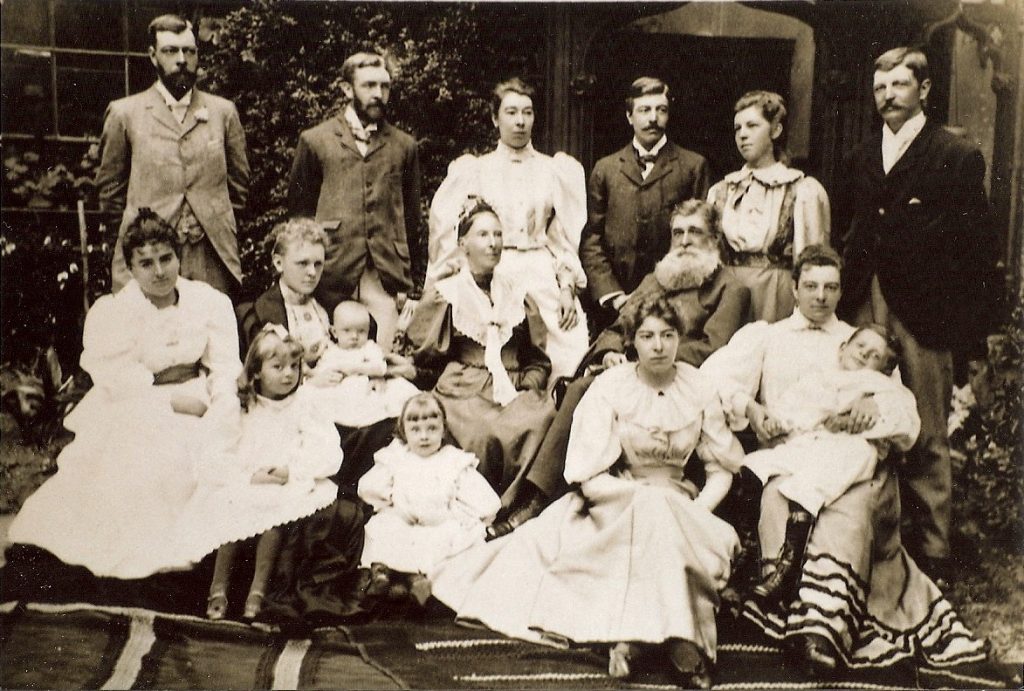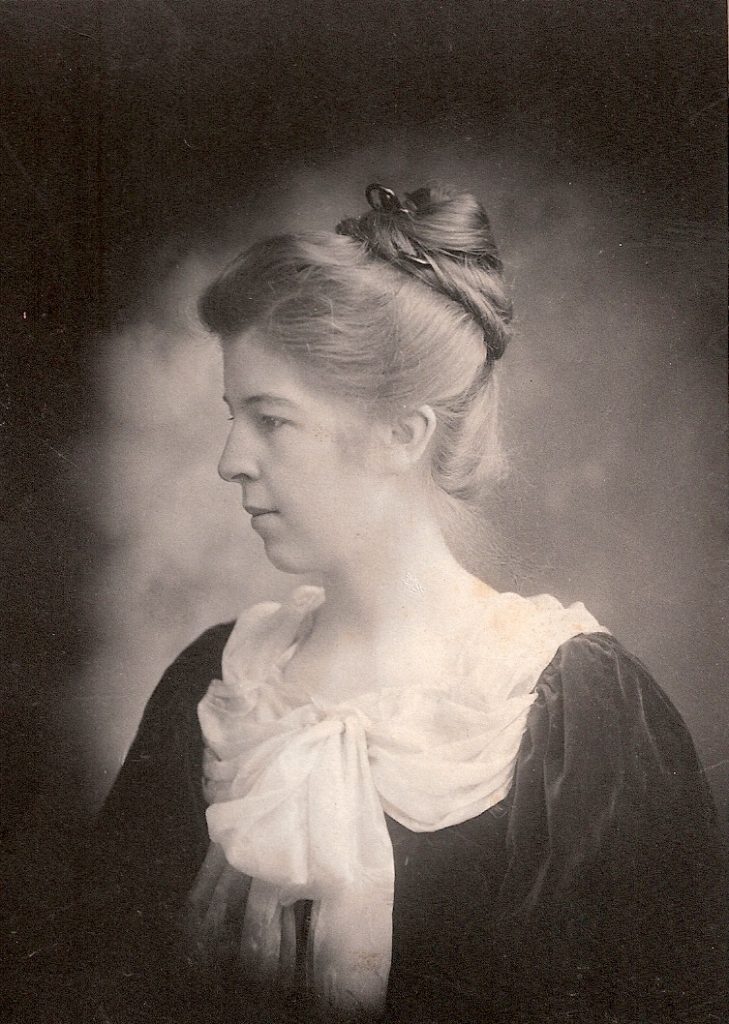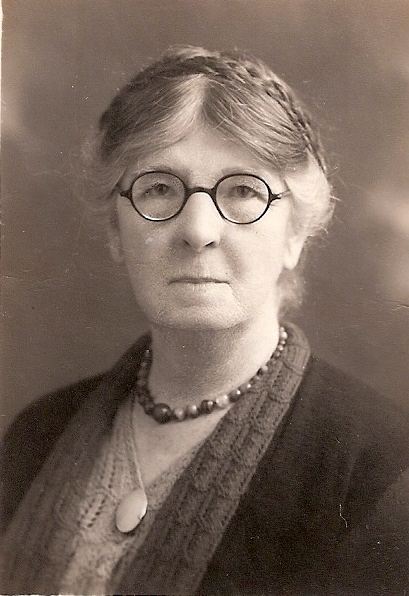On the eve of the First World War, just over a century ago, the militant “Suffragette” movement demanding votes for women was in full-swing. The names of Emmeline Pankhurst and her daughters Christabel and Sylvia, who founded the suffragette Women’s Social and Political Union (WSPU) in 1903, are still widely recalled, as is their campaign of direct, often violent, agitation. But mention of the peaceful “Suffragist” movement, which had been going for almost fifty years by 1914, produces blank looks nowadays. My great-great aunt Edith Eskrigge (1872-1948) was an active suffragist, and deserves to be celebrated for her lifetime of selfless public service.
Unlike the Pankhursts and their followers, Edith did not go in for window-smashing, or fire-setting, or painting-slashing or attacking cabinet ministers with dog-whips. Nor did she endure terms of imprisonment and bouts of force-feeding. She was also unlike the socially influential Pankhursts in having a provincial middle class upbringing, being the sixth child of seven born into a prosperous merchant’s family at Liscard Vale, Wallasey, on the opposite bank of the Mersey from Liverpool. Her father worked as a cotton broker in Liverpool, and a photograph, taken in the 1890s, has the family posed outside their large house (which stood where Vale Park is now, in New Brighton) in all their sober, but splendid, late-Victorian self-assurance. Edith, then in her early twenties, is standing, second from the right.

(An Eskrigge Family Portrait: Private Collection)
A keen sense of social concern was instilled in Edith by her non-conformist background (Quaker on her mother’s side and Congregationalist on her father’s), which discouraged bright girls from living lives of moneyed idleness. Starting out working in London’s East End at the Canning Town Settlement, she became immersed in voluntary social work. On her return home, she taught disabled children and undertook charitable work on their behalf, particularly in establishing Invalid Children’s Aid, later the Child Welfare Association. During the First World War she was Chief Officer of the Soldiers and Sailors Family Association in Liverpool, when she worked closely with Eleanor Rathbone. Afterwards she became Hon. Secretary of the Liverpool Women’s Citizen’s Association, which was concerned with preparing women for their duties as citizens. Later she took an active interest in the Lancashire and Cheshire Child Adoption Society. But she declined to become a magistrate, being dubious of the value of imprisonment and unwilling to be responsible for imposing it.

(A Youthful Edith: Private Collection)
My mother remembers her great-aunt Edith, by then an elderly lady, as an influential role model. In order that opinion about the place of women in society be altered, it was necessary for women like Edith to demonstrate their suitability to public office by means of pioneering example. But my mother also remembers the private Edith as a generous woman with a great gift for friendship, who was the pivotal member of the extended family and who took responsibility for the care of its ailing members. Edith had a horror of violence and war, and hoped that the influence of women in public affairs would be for peace. But she was broad-minded and undogmatic in her approach to any given issue, always being able to see both sides of an argument. Although briefly engaged in the 1890s, she never married. She was outgoing, nevertheless, and was a lifelong enthusiast for the outdoor pursuits of walking, climbing and cycling. She also travelled a good deal abroad.

(An Elderly Edith: Private Collection)
Her capacities for organisation and public speaking were used to the fullest extent in the suffragist movement. She was much involved in running the pre-war West Lancashire, West Cheshire and North Wales Federation of the National Union of Women’s Suffrage Societies (NUWSS) led nationally by Millicent Fawcett. This explicitly non-political and non-militant organisation set out to campaign by persuasion on a range of social issues, as well as on the cause of women’s suffrage. Edith was especially prominent in promoting the educational side of her federation’s work, particularly at the summer school held at Talybont in North Wales to train women working in the federation. It was through her great-aunt’s connections in Talybont that my mother and her brother were evacuated there as children from Wallasey, during the Second World War blitz.
In 1913 the suffragist NUWSS staged a Women’s Suffrage Pilgrimage, wherein its constituent federations marched to London during June and July and combined in a great demonstration at Hyde Park on July 26th. Edith organised and led her federation of the NUWSS’s contingent (of about 450 participants) which joined members of other federations to march on the “Watling Street” route from Carlisle to London. The Times estimated that about 50,000 people attended the eventual Hyde Park rally, which was conducted in a peaceful atmosphere designed to show the strength and extent of the non-violent suffrage movement. Suffragette Emily Wilding Davison had stepped to her death in front of the king’s horse at the Epsom Derby only weeks before, and it is interesting to note that this lone act of horror is routinely replayed in modern media accounts of the period whilst the peaceful activities of thousands of women like Edith seldom rate a mention.
Of course such efforts did not secure parliamentary votes for women before the First World War, but then again neither did the more sensational actions of the suffragettes. It is not generally appreciated that the organised suffragist movement traced its origin back almost half a century to the formation of the “Kensington Society” in 1866, since when it had been advocating a broad range of women’s rights with a fair degree of success. It had secured the important objective of legal property rights for married women, and had seen female ratepayers obtain the right to vote and stand as candidates in local government. For the first time, in the late nineteenth century, women established themselves in large numbers as members of public bodies. In such ways suffragists like Edith were influential in shifting opinion toward an acceptance that women had a rightful place in public life as well as in the home. The question of the franchise was not, in any case, a clear-cut gender divide, because a large minority of men did not themselves have the vote in parliamentary elections before the First World War. It took the wartime sacrifices of men and women alike before this right was extended to all adult males, and to women over the age of thirty, at the war’s end in 1918. Full electoral equality between the sexes was not granted until 1928.
A good friend of hers wrote that Edith: “was one to whom cultural pleasures of the mind came as naturally as breathing and throughout her life she absorbed knowledge like sunlight and made it part of herself.” That friend also wrote that Edith “remained to the end essentially an open air person of country tastes and with a primitive gypsy element in her composition…She would say that mountains intoxicated her, and that nothing gave her such pleasure as nature. She had indeed great knowledge of natural objects and wild creatures, and acute powers of observation; she was also something of a weather prophet…On long walks she would often sleep on the ground, a form of rest which gave her instinctive enjoyment and fulfilled some primitive urge…The ‘sense of wonder’ never failed her…There were no windows closed on life…Her essential wisdom, her readiness to appreciate the good in life and accept the painful, made her a restful as well as a profoundly stimulating companion.”
I would love to have known her.
A collection of papers and photographs relating to Edith Eskrigge is held at The Women’s Library at the LSE (Ref: 7EES)
